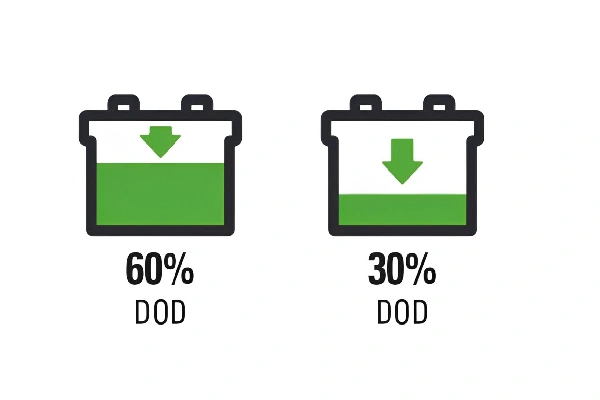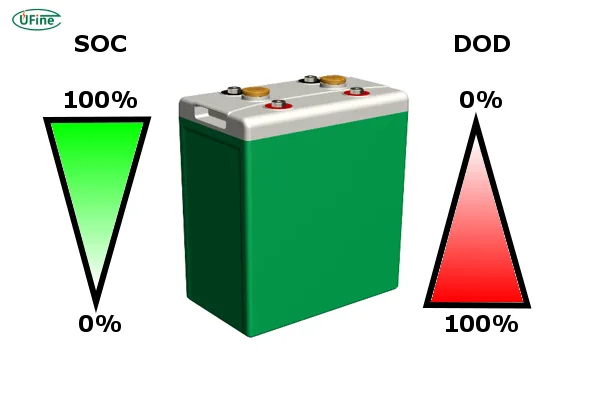
- Part 1. What is the depth of discharge (DoD)?
- Part 2. DoD vs battery capacity
- Part 3. Depth of discharge vs State of Charge (SoC)
- Part 4. How does DoD affect the cycle life?
- Part 5. Depth of discharge of different types of batteries
- Part 6. How to calculate the DoD of a battery?
- Part 7. Depth of discharge: Is the higher the better?
- Part 8. Practical tips to manage DoD
- Part 9. FAQs
Quick Answer Depth of Discharge (DoD) is one of the most important metrics for understanding battery health and usage. Whether you’re using a lithium-ion battery for your electric vehicle, solar storage, or portable device, knowing your battery’s DoD can help maximize its lifespan and performance. In this guide, we’ll explain everything you need to know about DoD, how to calculate it, and how it affects your battery.
Part 1. What is the depth of discharge (DoD)?
Depth of Discharge (DoD) refers to the percentage of a battery’s capacity that has been discharged relative to its maximum capacity. It is a critical parameter in rechargeable batteries, particularly in applications like electric vehicles, renewable energy storage systems, and portable electronics.
It tells you how full or empty the battery is after it has been used. For example, if a battery is only half full after use, the DoD is 50%. It helps us understand how much energy is left in the battery and how much more it can be used before recharging.
Depth of Discharge (DoD) is kind of like peeking into your car’s gas tank to see how much fuel you’ve used. It tells you how much energy has been used from a battery compared to its full capacity. So, if a battery is half empty, its DoD is 50%.
Part 2. DoD vs battery capacity
Depth of Discharge (DoD) and capacity are different aspects of a battery’s performance.
Capacity refers to the total amount of energy a battery can store. It’s like the size of a tank that determines how much fuel it can hold.
On the other hand, DoD is about how much of that energy has been used up or discharged from the battery. It tells you how full or empty the battery is after being used, like checking how much fuel is left in the tank after driving.
Capacity is a fixed value representing the maximum energy the battery can hold, while DoD varies and shows how much of that capacity has been used.
For example, if a battery has a capacity of 100 units of energy, using 50 units means the DoD is 50%, indicating that half of the battery’s capacity has been used.
| Term | Meaning | Analogy |
|---|---|---|
| Capacity | Total energy the battery can hold | Size of a gas tank |
| DoD | How much energy has been used | How much fuel did you use |
Understanding the difference between capacity and DoD helps us know the battery’s remaining energy level and how much more we can use before recharging. It’s like knowing the tank size and checking the fuel gauge in a car to see how much driving you can do before refueling.
Part 3. Depth of discharge vs State of Charge (SoC)
Depth of Discharge (DoD) and State of Charge (SoC) are two different ways to measure the energy level of a battery.
Learn how battery State of Charge (SoC) and State of Health (SoH) impact performance and lifespan.
DoD measures how much energy has been used up or discharged from the battery, indicating how empty or full it is after being used.
On the other hand, SoC measures the current level of energy remaining in the battery, indicating how full or empty it is at a given moment.
Think of it like a glass of water. The DoD tells you how much water has been consumed from the glass, while the SoC tells you the current level of water remaining in the glass.
DoD is like looking at the glass after drinking some water to see how much is left, while SoC is like checking the glass at any time to see how full or empty it is.
Both DoD and SoC are important for understanding the battery’s energy status. DoD helps determine how much energy has been used over time. SoC provides a snapshot of the battery’s current energy level.
By considering both DoD and SoC, we can effectively manage the battery’s usage and recharge it when needed, just like knowing how much water is left in the glass and deciding when to refill it.
Discover simple methods to measure your battery’s SoC and monitor its energy levels: Quick Guide: How to Measure SOC of a Battery
Part 4. How does DoD affect the cycle life?
Cycle life is the total number of charge-discharge cycles a battery can endure before it loses significant capacity. DoD plays a big role:
- High DoD (deep discharge): Shortens cycle life
- Low DoD (shallow discharge): Extends cycle life
Rule of thumb: Keeping DoD moderate helps your battery last longer. For example, lithium-ion batteries last longer when discharged only 20–30% each cycle rather than 80–100%.
Part 5. Depth of discharge of different types of batteries
It’s like each battery type has its own “safe zone” for how much you can drain before recharging. So, when using different batteries, it’s important to know their specific depth of discharge limits to maximize their lifespan.
Different types of batteries have different depths of discharge limits.
| Battery Type | Recommended Max DoD | Notes |
|---|---|---|
| Lithium-ion (Li-ion) | 80% | Avoid deep discharges below 20% remaining charge |
| Lead-acid | 50% | Can handle deeper discharges, common in cars |
| NiCd / NiMH | 80% | Tolerant of deeper discharges without severe damage |
1. Lithium-ion (Li-ion) battery depth of discharge
For lithium-ion (Li-ion) batteries, it is generally recommended to avoid deep discharges below 20% to prolong their lifespan. This means you shouldn’t drain them more than 80% before recharging.
2. Lead-acid battery depth of discharge
Lead-acid batteries, commonly used in automotive applications, can tolerate deeper discharges, typically up to 50% DoD, without a significant impact on their longevity.
3.NiCd and NiMH battery depth of discharge
Nickel-based batteries, like nickel-cadmium (NiCd) and nickel-metal hydride (NiMH) batteries, are also more resilient to deep discharges and can handle DoDs of around 80% without severe consequences.
Pro tip: Always check the manufacturer’s guidelines for DoD limits.
Compare the top rechargeable batteries for solar lights and find out which performs best: Best Rechargeable Batteries for Solar Lights: Lithium vs NiMH vs NiCd Compared
Part 6. How to calculate the DoD of a battery?
Calculating the depth of discharge (DoD) of a battery is straightforward.
To calculate DoD, you need to know the initial capacity of the battery (the total energy it can hold) and the amount of energy that has been discharged from the battery.
Here’s a simplified formula to calculate the depth of discharge (DoD) of a battery:
DoD = (Discharged Energy / Initial Capacity) x 100%
- DoD is the depth of discharge
- Discharged Energy is the amount of energy that has been discharged from the battery
- Initial Capacity is the total energy capacity of the battery
First, the initial capacity of the battery, usually expressed in Amp-hours (Ah) or Watt-hours (Wh), is determined.
Next, measure or estimate the amount of energy that has been discharged from the battery, also in Ah or Wh.
To calculate the DoD, divide the discharged energy by the initial capacity and multiply by 100 to get the percentage.
For example, if a battery with a capacity of 100 Ah has been discharged by 50 Ah, the DoD would be (50 Ah / 100 Ah) x 100% = 50%.
Depth of discharge is a relative measure and can change with each discharge cycle. It’s important to recalculate the DoD each time the battery is used to get an accurate understanding of its energy level.
Part 7. Depth of discharge: Is the higher the better?
No, a higher depth of discharge is not necessarily better for a battery.
In fact, it’s generally recommended to avoid high DoD levels for most batteries.
Using a higher DoD means draining more energy from the battery before recharging it. While it may provide more usage in the short term, it can have negative effects on the battery’s lifespan and overall performance.
Frequent deep discharges can contribute to accelerated battery degradation, reducing its capacity and shortening its usable life.
To maximize the longevity of a battery, it’s advisable to keep the depth of discharge within the recommended limits provided by the manufacturer. This helps maintain the battery’s health, extend its cycle life, and ensure it can deliver reliable performance over an extended period.
Part 8. Practical tips to manage DoD
- Use a Battery Management System (BMS): Monitors DoD and prevents over-discharge.
- Charge Regularly: Avoid letting batteries sit at high DoD for long periods.
- Follow Manufacturer Guidelines: Each battery chemistry has its own safe DoD range.
- Record Usage: Track cycles and DoD for better maintenance.
- Consider Shallow Cycles: Partial discharges can greatly increase cycle life.
Part 9. FAQs
Can I calculate DoD without a BMS?
Yes, measure the energy used and apply the formula, but BMS makes tracking more accurate.
Does temperature affect DoD?
Yes, extreme cold or heat can reduce battery usable capacity.
How does DoD relate to battery warranty?
Some manufacturers base warranty on cycle counts at a certain DoD. High DoD may shorten coverage.
Is DoD relevant for solar storage batteries?
Absolutely. Maintaining proper DoD maximizes storage lifespan and ensures reliable energy supply.
Can improper DoD cause permanent battery damage?
Yes. Excessive deep discharges can damage electrodes or electrolytes, reducing total capacity.
Related Tags:
More Articles

Battery Load Test: A Comprehensive Guide
Step-by-step battery load test guide for car, solar & industrial use. Learn how to load test a battery, interpret voltage charts, and avoid common mistakes.
The Comprehensive Guide to Battery Balancing and Battery Balancer
Discover how battery balancers improve lithium battery performance, lifespan, and safety. Learn types, functions, and tips to choose the right balancer.
What Is the Best Voltage for a Chainsaw Battery?
Compare 12V-80V chainsaw batteries for light pruning, medium firewood, and professional cutting. See best battery chainsaw with runtime charts and safety tips.
Lithium VS. Alkaline Batteries: A Comprehensive Comparison
Lithium batteries last 3–7× longer than alkaline and perform better in cold weather. Compare lifespan, cost, safety, and best uses to choose the right battery.
Comparing Lithium-Sulfur and Lithium-Ion Batteries: Which is Right for You?
Compare lithium-sulfur (Li-S) and lithium-ion batteries on energy, lifespan, cost, safety, and applications. Best choice for drones, EVs, and electronics.





